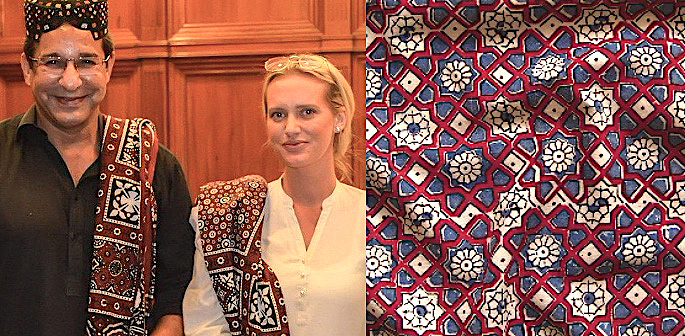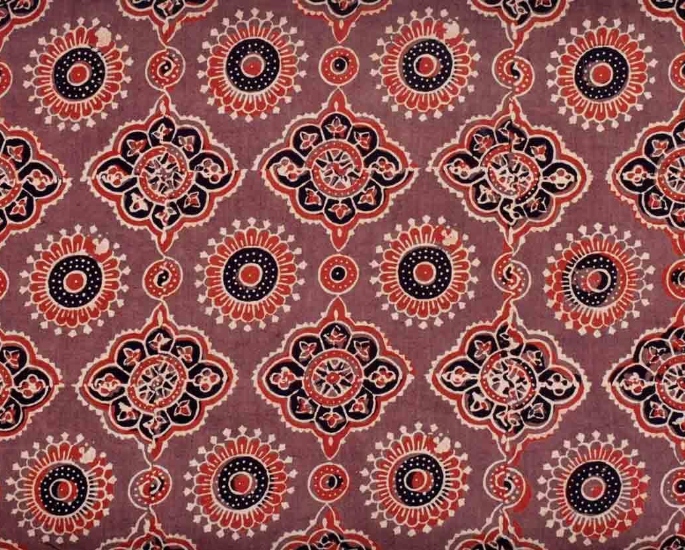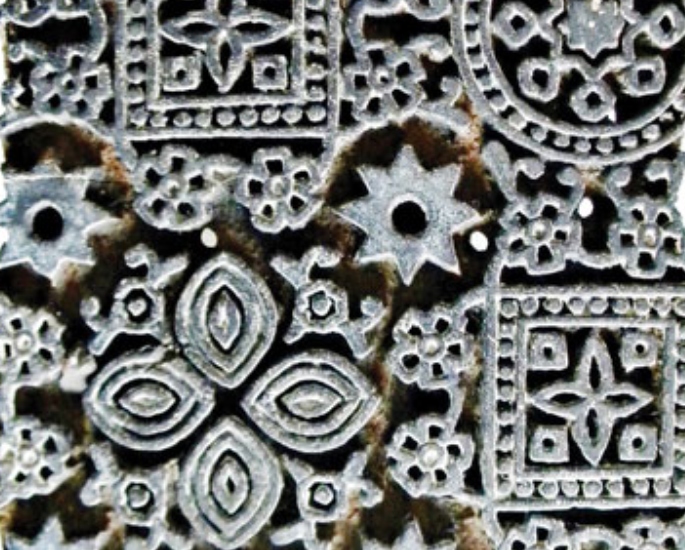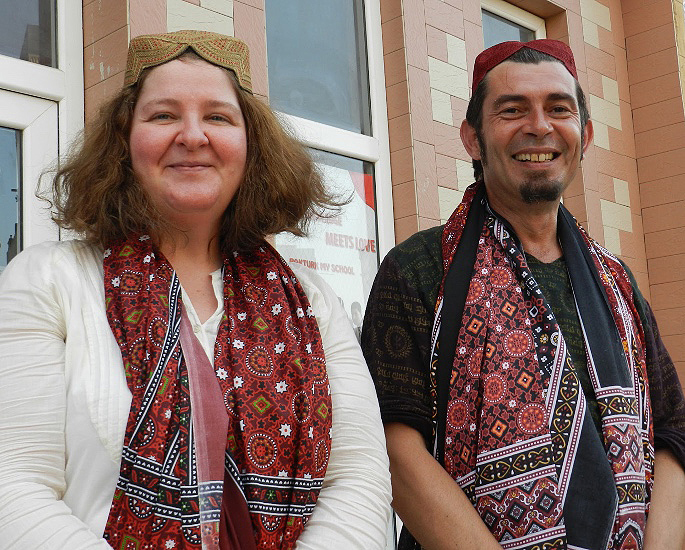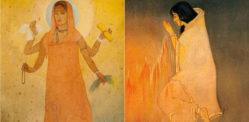"The craft is indigenous to Sindh"
Ajrak art is a special form of hand block printing which had begun in Sindh, Pakistan prior to the partition of India.
People from all over the world love Sindhi Ajrak designs, particularly with the beautiful art of colours and blocks to differentiate them.
The history of the Ajrak goes back in time, connecting with cotton An early settlement from the lower Indus Valley came up with a way to grow the Gossypium Arboreum or Cotton tree. Those civilisations were said to have mastered making cotton clothes.
There is no connection between Ajrak with class or status. The Ajrak is a special handmade craft from Sindh with both rich and poor wearing it.
Initially, Ajrak block designs were made on shawls, In modern times Ajrak features a wide range of products such as ladies’ suits, dupattas, sarees, bedsheets and much more. It has gone onto to become a fashion statement across the globe.
Ajrak block paints are made naturally. Mineral and vegetable dyes are commonly used in Ajrak products. Most noteworthy, Indigo is the key colour in this craft.
DESIblitz goes deeper to put light on the soul of Ajrak art.
Historical Perspective
Ajrak art traces its roots to Sindhu or Indus River, which emanates from the great Himalayas, flowing towards Punjab and going into Sindh.
This goes back to 2500 BCE, during the Indus Valley Civilisation period, when the plant Indigo or Indigofera Tinctoria grew plentifully on the Indus banks. Later in 1843 when the British took over Sindh, Indigo became a major export at the time.
There is also a connection from the 9th to the 14th century, when Sindh and Egypt Arab traders used to export spices and textiles.
The name Ajrak come from word Azrak, which means blue in Arabic. Natives from Sindh highly regard this textile as they take it as a blessing to them.
This cloth is not only used on special occasions but also in everyday life. Right after the birth of the child to wedding and deaths, Ajrak commemorates aspects life.
On November 6, 2019, Reporter Shazia Nayyar commented about the attractive Ajrak, tweeting
“A very beautiful gift of #Ajrak by #JUIF in #AzadiMarch for all female reporter who are covering the March.”
It is believed that the Maldhari Pastoral community of Sindh, Pakistan started Ajrak.
Making of Ajrak
The process of Ajrak consists of twenty-one stages and is very complex. Nature plays a very important part in the making of Ajrak. This is because the colours that artisans use in making Ajrak are created with local herbals and vegetables.
The craftsmen work in total harmony with the atmosphere, as the natural material is the key ingredient of this art.
The cloth is washed properly with river or lake water at every stage. Also, artisans do their washing process early in the morning.
Moreover, traditional Ajrak called Teli (oily) Ajrak takes almost one month to complete the process.
The base cloth (Kora latha), which means clear cloth in Hindi or Urdu language, is a twisted cloth that is steamed in the copper vat (khumbh) the whole night.
After that, the cloth is brought to the shop to soak in Eruca Sativa seed oil to give the base cloth. Then the bundle of base cloth is kept for fifteen days in the seed oil, water, and camel dung. Camel dunk helps the cloth to soften up and act as a natural bleaching agent.
Mir Shk sharing his thoughts about the documentary on Ajrak by the MI Khatri family, said:
“The craft is indigenous to Sindh and came in kutch through migration.”
Block Printing
After doing all the soaking and washing process for days then the cloth gets print-ready when the blockwork starts. Woodblocks are made with AcaciaArabica trees, a native of the Sindh region.
The recurrence form, which elasticities the design into its character, is resolute by a grid system. The phenomenal geometry motif on the cloth comes from the method of woodblock printing.
The outline is first transferred to the block and then imprinted with great accuracy by the block-maker, who uses very meek tools.
The blocks are produced in pairs that can copy an exact reversed image on the other side. Block printing is the most noteworthy process that completes the Ajrak item.
First, the cloth is put and spread onto a table. The artists smother wooden blocks with resist and hover them over the textile to ensure a balanced application.
Once they are ready, the block is pounded on the cloth with a heavy-forced whack. This same gesticulation is performed quite a lot times until the cloth is entirely enclosed with the block’s outline.
In comtemporary times, some families have witnessed a decline in block printing. Ahmed Amjad who runs a block printing shop in Karachi told The Express Tribune:
“My father and grandfather spend their lives earning a livelihood through block printing.”
“But the decline in business has convinced me not to let my children join the profession, which will end the years-long legacy of block printing in my family.”
International Fancy
Ajrak maybe synonymous with Sindh, Pakistan but is known all over the world. People love the simplicity of an elegant Ajrak that one can use in thier daily lives as well as on the occasions.
Ajrak is displayed in many exhibitions nationally. But with the growing awareness, it is also exhibiting internationally.
Many designers are using Ajrak with a touch of other desi techniques like gota (emroidery) and sequences. The creativity of using Ajrak has reached far afield.
Most importantly New-York fashion brand Sea has made Ajrak sleeveless tops and named them Ezri sleeveless tops.
It is amazing to see that Sindhi Ajrak is flourishing internationally. The symbol of respect and culture of Sindh, Pakistan, has come so far and known for its simplicity and hard work behind it.
Celebrities from Karachi or visiting the City of Lights’ enjoy wearing the Ajrak.
Pakistan cricket legend Wasim Akram and his Australian wife Shaniera Akram have previously worn the this shawl.
Similarly, other foreign sports personalities such as Luis Figo (POR) and Kaka (BRZ) have been presented with this traditional scarf on arrival to Pakistan.
Ajrak is an art that is completely eco and counts as one of the oldest arts. Also, it is said that every colour that uses to make Ajrak has a story.
Red for the earth, black for darkness, blue for the universe and white for the clouds. From cloth to colours Ajrak is made completely with a natural process.
People from Sindh never forget to buy Ajrak on the auspicious occasion of Eid. People take Ajrak as an honor and pride from Sindh Pakistan.
Moreover, it is said that the Ajrak artisans in India are originally from Sindh, Pakistan. The craft is also very popular across states of India, inlcuding Rajasthan and Gujarat.



















































